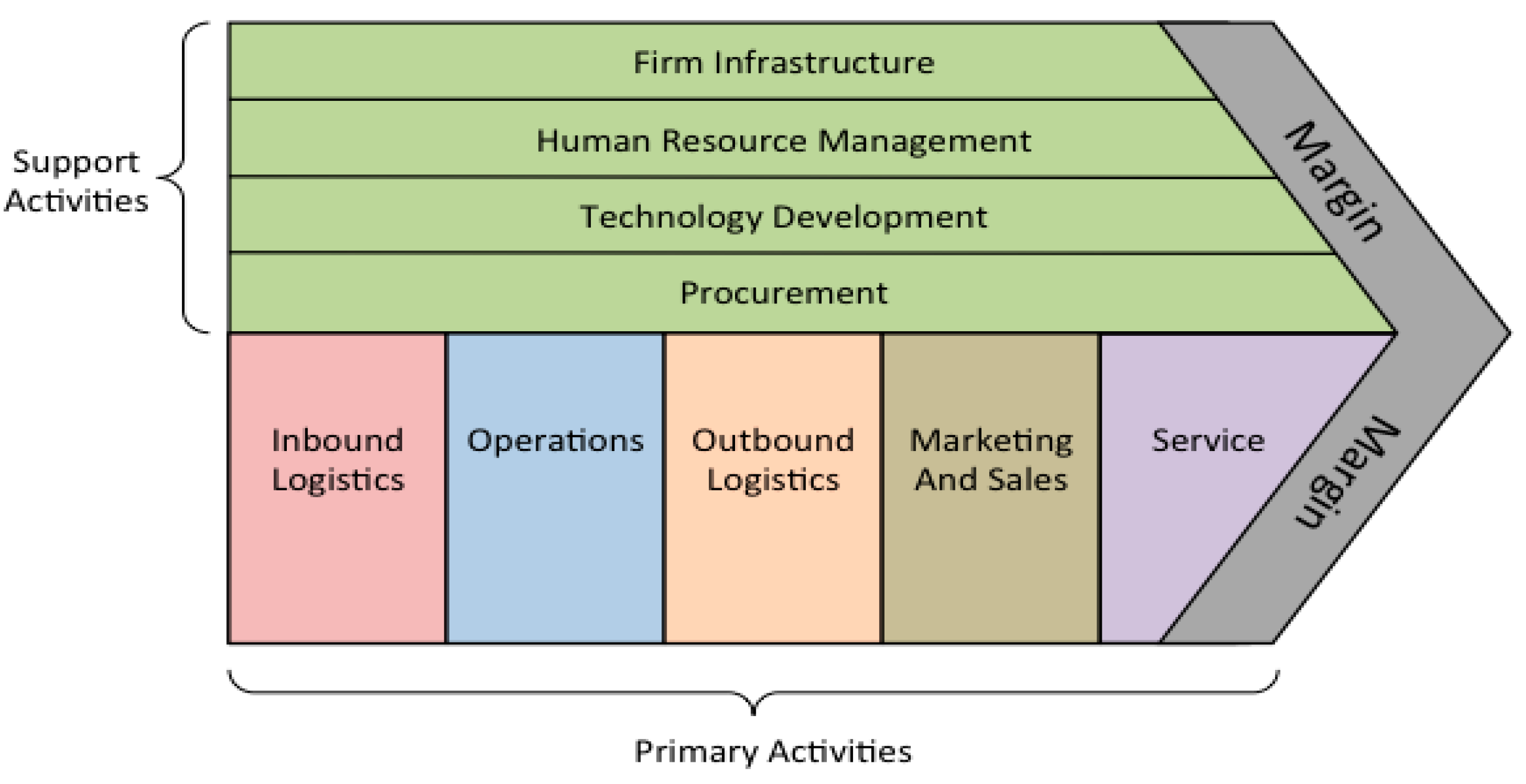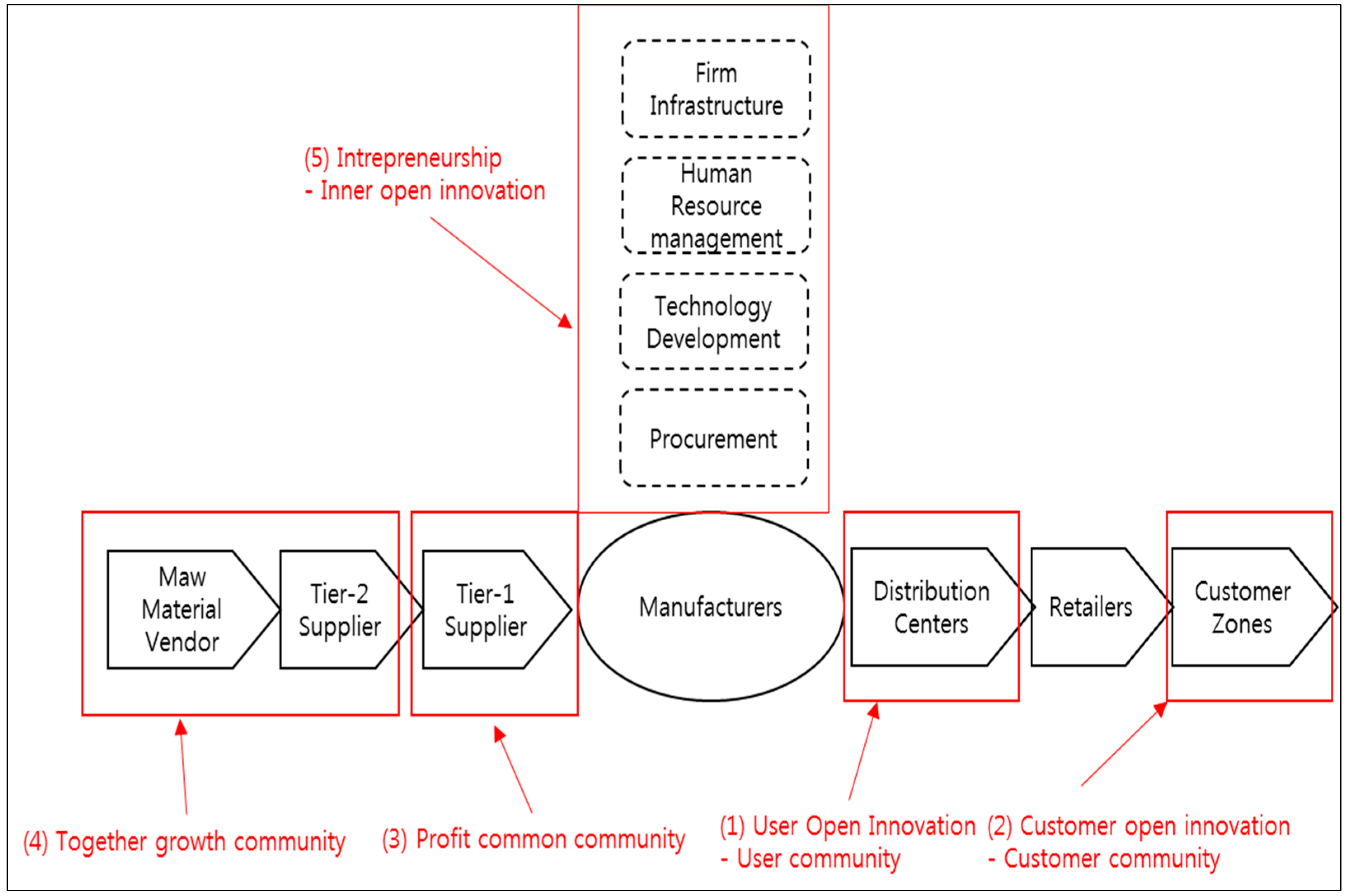Open Innovation in Value Chain for Sustainability of Firms
Abstract
:1. Introduction
2. Literature Review
3. Approaches and Methods
- (1)
- User open innovation: When users of the products are not end users of those production lines, producers can innovate based on the opinions of organized users including user communities. Most medical instrument producers organize communities of doctors or nurses to receive innovative ideas from them systemically.
- (2)
- Customer open innovation: Computer companies, high-end smartphone companies, or luxurious auto–bicycle companies organize customer communities, and receive customer innovation requirements, or additional innovative ideas. Open innovation from the customer’s perspective is the newest connection between existing technology, and the new market. Thus, open customer innovation normally motivates market growth directly with incremental innovation.
- (3)
- Common profit community: Toyota automotive tries to innovate by itself, or let direct suppliers innovate. If a direct supplier innovates, and Toyota makes profits from the innovation, then Toyota tries to share the benefits from the innovation with the supplier. This common profit community provides and incentive for suppliers to innovate, and gives the producer an opportunity to obtain benefits from the innovation activity. Common profit community motivates the supplier to actively innovate.
- (4)
- Together growth community: Together growth communities are organized by Korean Hyundai Motors at the Lee Myung-Bark Presidency. If producers make any profits from innovations proposed by suppliers, then they try to distribute the benefits from the innovation to supplies in the supply chain. Together growth community can be a kind of open innovation channel in the supply chain without additional costs, if it is well organized by producers.
- (5)
- Inner open innovation: Within the producer, any individual or group can develop a new idea about the creative connection between technology and the market; this is a kind of inner open innovation mechanism. If a producer organizes an inner open innovation system such as an inner venture system, spin-off system, or spin-out system well, then producers can continuously develop a new business model by themselves.
4. The Special Issue
Acknowledgments
Author Contributions
Conflicts of Interest
References
- Geus, A. The Living Company: Growth, Learning and Longevity in Business; Nicholas Brealey Publishing: London, UK, 2011. [Google Scholar]
- Burgelman, R.A.; Grove, A.S. Let chaos reign, then rein in chaos—Repeatedly: Managing strategic dynamics for corporate longevity. Strateg. Manag. J. 2007, 28, 965–979. [Google Scholar] [CrossRef]
- Parkhe, A. Interfirm diversity, organizational learning, and longevity in global strategic alliances. J. Int. Bus. Stud. 1991, 22, 579–601. [Google Scholar] [CrossRef]
- Schumpeter, J.A. Capitalism, Socialism and Democracy; Routledge: Abingdon-on-Thames, UK, 1942. [Google Scholar]
- Kramer, M.R.; Porter, M. Creating shared value. Harv. Bus. Rev. 2011, 89, 62–77. [Google Scholar]
- Porter, M.E. Competitive Advantage: Creating and Sustaining Superior Performance; Free Press: New York, NY, USA, 1985. [Google Scholar]
- Lambert, D.M.; Cooper, M.C. Issues in supply chain management. Ind. Mark. Manag. 2000, 29, 65–83. [Google Scholar] [CrossRef]
- Swaminathan, J.M.; Smith, S.F.; Sadeh, N.M. Modeling supply chain dynamics: A multiagent approach. Decis. Sci. 1998, 29, 607–632. [Google Scholar] [CrossRef]
- Rayport, J.F.; Sviokla, J.J. Exploiting the virtual value chain. Harv. Bus. Rev. 1995, 73, 75. [Google Scholar]
- Hansen, M.T.; Birkinshaw, J. The innovation value chain. Harv. Bus. Rev. 2007, 85, 121. [Google Scholar] [PubMed]
- Kaplinsky, R. Globalisation and unequalisation: What can be learned from value chain analysis? J. Dev. Stud. 2000, 37, 117–146. [Google Scholar] [CrossRef]
- Moon, T.H.; Kim, D.-H.; Park, C.S.; Lee, D.-S. Policy Analysis to Reduce Climate Change-Induced Risks in Urban and Rural Areas in Korea. Sustainability 2017, 9, 524. [Google Scholar] [CrossRef]
- Cooke, P. Green governance and green clusters: Regional & national policies for the climate change challenge of Central & Eastern Europe. J. Open Innov. Technol. Mark. Complex. 2015, 1, 1. [Google Scholar]
- Kim, E.; Ha, Y.; Kim, S. Public Debt, Corruption and Sustainable Economic Growth. Sustainability 2017, 9, 433. [Google Scholar] [CrossRef]
- Shim, S.-O.; Park, K. Technology for Production Scheduling of Jobs for Open Innovation and Sustainability with Fixed Processing Property on Parallel Machines. Sustainability 2016, 8, 904. [Google Scholar] [CrossRef]
- Yun, J.J. How do we conquer the growth limits of capitalism? Schumpeterian Dynamics of Open Innovation. J. Open Innov. Technol. Mark. Complex. 2015, 1, 17. [Google Scholar] [CrossRef]
- Lim, J.-Y.; Yoo, S.H.; Won, D. A Human-Needs-Based Dynamics to Simulate Technology Policy and Its Effects on Both Business Success and Human Happiness. Sustainability 2016, 8, 1225. [Google Scholar] [CrossRef]
- Yun, J.J.; Cooke, P.; Kodama, F.; Phillips, F.; Gupta, A.K.; Gamboa, F.J.C.; Krishna, V.; Lee, K.; Lee, K.R.; Witt, U.; et al. An Open Letter to Mr. Secretary General of the United Nations to Propose Setting up Global Standards for Conquering Growth Limits of Capitalism; Springer: Berlin, Germany, 2016. [Google Scholar]
- Won, D.; Yoo, S.; Yoo, H.; Lim, J. Complex adaptive systems approach to sewol ferry disaster in Korea. J. Open Innov. Technol. Mark. Complex. 2015, 1, 22. [Google Scholar] [CrossRef]
- Yusr, M.M. Innovation capability and its role in enhancing the relationship between TQM practices and innovation performance. J. Open Innov. Technol. Mark. Complex. 2016, 2, 6. [Google Scholar] [CrossRef]
- Jeong, S.; Han, J.; Kim, J. A Systematic Approach to Identify Promising New Items for Small to Medium Enterprises: A Case Study. Sustainability 2016, 8, 1158. [Google Scholar] [CrossRef]
- Yun, J.J.; Jeong, E.; Yang, J. Open innovation of knowledge cities. J. Open Innov. Technol. Mark. Complex. 2015, 1, 16. [Google Scholar] [CrossRef]
- Kim, J.-H.; Jung, S.-H. Study on CEO characteristics for management of public art performance centers. J. Open Innov. Technol. Mark. Complex. 2015, 1, 5. [Google Scholar] [CrossRef]
- Lee, S.-H.; Workman, J.; Jung, K. Perception of Time, Creative Attitudes, and Adoption of Innovations: A Cross-Cultural Study from Chinese and US College Students. Sustainability 2016, 8, 1193. [Google Scholar] [CrossRef]
- Kodama, F.; Shibata, T. Demand articulation in the open-innovation paradigm. J. Open Innov. Technol. Mark. Complex. 2015, 1, 2. [Google Scholar] [CrossRef]
- Lee, H.; Kim, N.; Kwak, K.; Kim, W.; Soh, H.; Park, K. Diffusion Patterns in Convergence among High-Technology Industries: A Co-Occurrence-Based Analysis of Newspaper Article Data. Sustainability 2016, 8, 1029. [Google Scholar] [CrossRef]
- Della Corte, V.; Iavazzi, A.; D’Andrea, C. Customer involvement through social media: The cases of some telecommunication firms. J. Open Innov. Technol. Mark. Complex. 2015, 1, 10. [Google Scholar] [CrossRef]
- Lara, A.; Costa, E.; Furlani, T.; Yigitcanlar, T. Smartness that matters: Comprehensive and human-centred characterisation of smart cities. J. Open Innov. Technol. Mark. Complex. 2016, 2, 1–13. [Google Scholar] [CrossRef]
- Pancholi, S.; Yigitcanlar, T.; Guaralda, M. Public space design of knowledge and innovation spaces: Learnings from Kelvin Grove Urban Village, Brisbane. J. Open Innov. Technol. Mark. Complex. 2015, 1, 13. [Google Scholar] [CrossRef]
- Patra, S.K.; Krishna, V.V. Globalization of R&D and open innovation: Linkages of foreign R&D centers in India. J. Open Innov. Technol. Mark. Complex. 2015, 1, 7. [Google Scholar]
- Yun, J.J.; Lee, D.; Ahn, H.; Park, K.; Yigitcanlar, T. Not deep learning but autonomous learning of open innovation for sustainable artificial intelligence. Sustainability 2016, 8, 797. [Google Scholar] [CrossRef]
- Yun, J.J.; Won, D.; Park, K. Dynamics from open innovation to evolutionary change. J. Open Innov. Technol. Mark. Complex. 2016, 2, 7. [Google Scholar] [CrossRef]
- Yun, J.J.; Jeong, E.; Park, J. Network Analysis of Open Innovation. Sustainability 2016, 8, 729. [Google Scholar] [CrossRef]
- Yoon, J.; Kim, D.-S. Empirical Relationships among Technological Characteristics, Global Orientation, and Internationalisation of South Korean New Ventures. Sustainability 2016, 8, 1254. [Google Scholar] [CrossRef]
- Lee, B.; Won, D.; Park, J.-H.; Kwon, L.; Moon, Y.-H.; Kim, H.-J. Patent-Enhancing Strategies by Industry in Korea Using a Data Envelopment Analysis. Sustainability 2016, 8, 901. [Google Scholar] [CrossRef]
- Jeon, J.-H.; Kim, S.-K.; Koh, J.-H. Historical review on the patterns of open innovation at the national level: The case of the Roman period. J. Open Innov. Technol. Mark. Complex. 2015, 1, 20. [Google Scholar] [CrossRef]
- Kim, S.-J.; Kim, E.-M.; Suh, Y.; Zheng, Z. The effect of service innovation on R&D activities and government support systems: The moderating role of government support systems in Korea. J. Open Innov. Technol. Mark. Complex. 2016, 2, 5. [Google Scholar] [CrossRef]
- Oganisjana, K. Promotion of university students’ collaborative skills in open innovation environment. J. Open Innov. Technol. Mark. Complex. 2015, 1, 18. [Google Scholar] [CrossRef]


© 2017 by the authors. Licensee MDPI, Basel, Switzerland. This article is an open access article distributed under the terms and conditions of the Creative Commons Attribution (CC BY) license (http://creativecommons.org/licenses/by/4.0/).
Share and Cite
Yun, J.J.; Yigitcanlar, T. Open Innovation in Value Chain for Sustainability of Firms. Sustainability 2017, 9, 811. https://doi.org/10.3390/su9050811
Yun JJ, Yigitcanlar T. Open Innovation in Value Chain for Sustainability of Firms. Sustainability. 2017; 9(5):811. https://doi.org/10.3390/su9050811
Chicago/Turabian StyleYun, JinHyo Joseph, and Tan Yigitcanlar. 2017. "Open Innovation in Value Chain for Sustainability of Firms" Sustainability 9, no. 5: 811. https://doi.org/10.3390/su9050811
APA StyleYun, J. J., & Yigitcanlar, T. (2017). Open Innovation in Value Chain for Sustainability of Firms. Sustainability, 9(5), 811. https://doi.org/10.3390/su9050811






